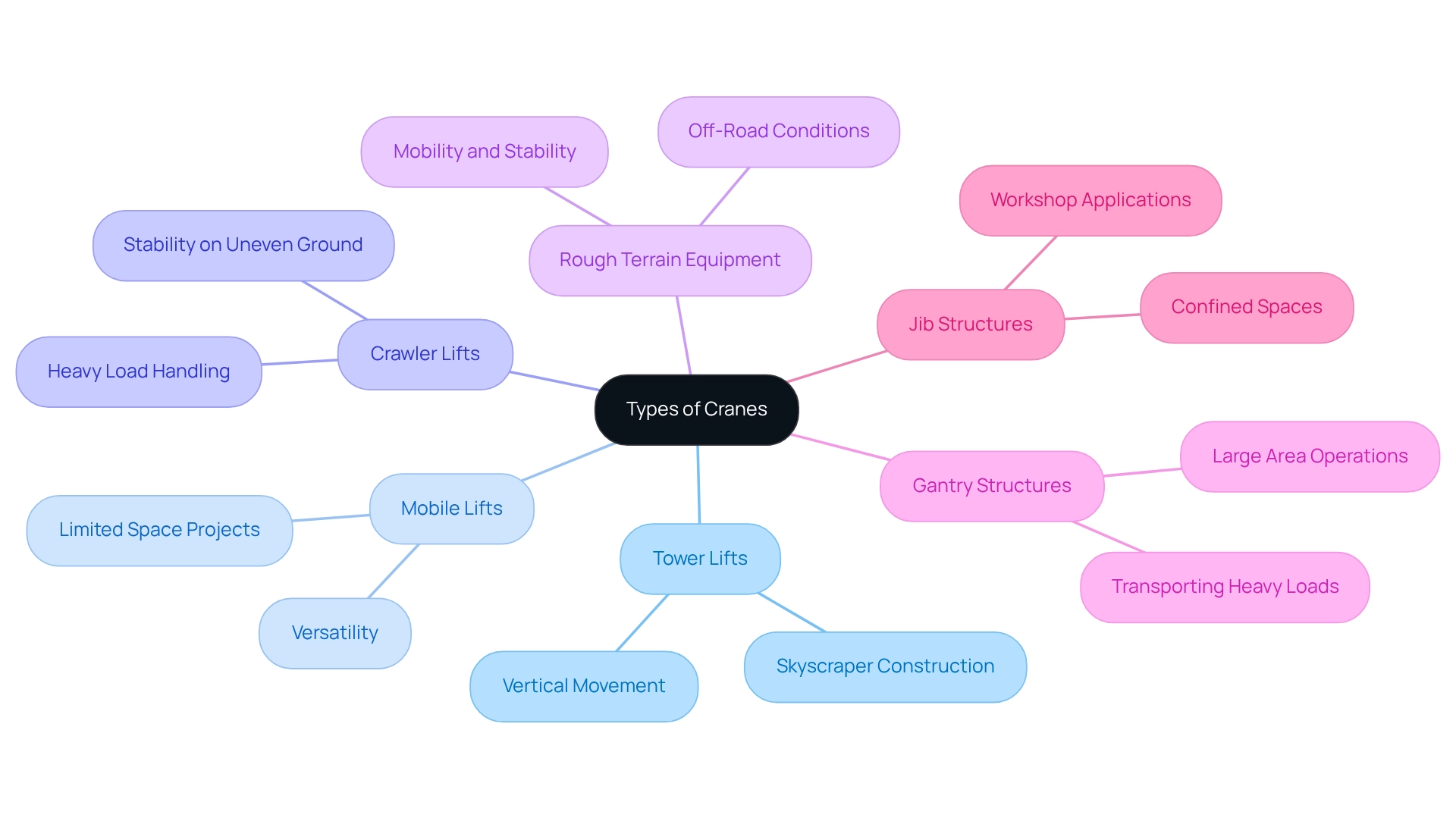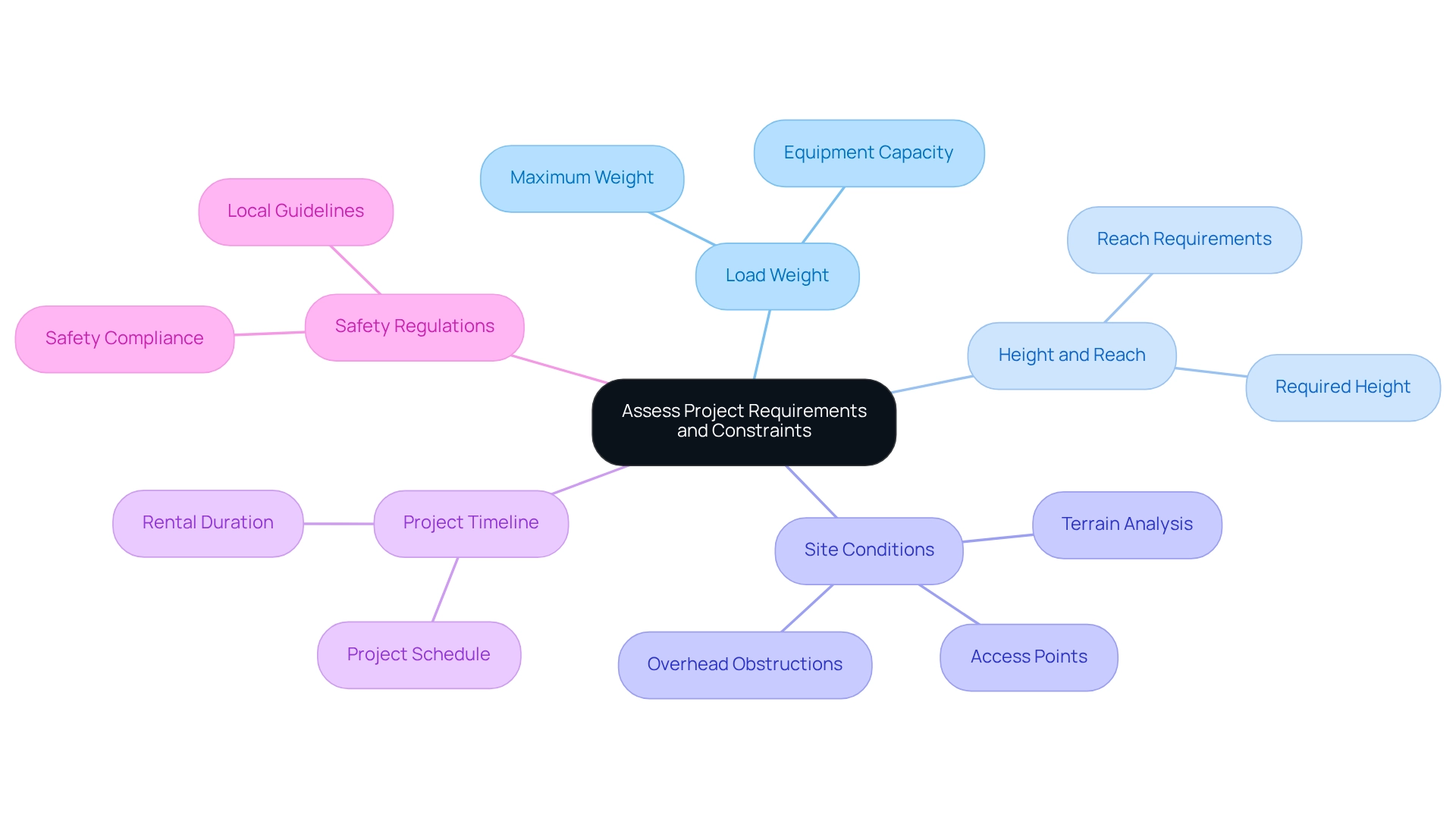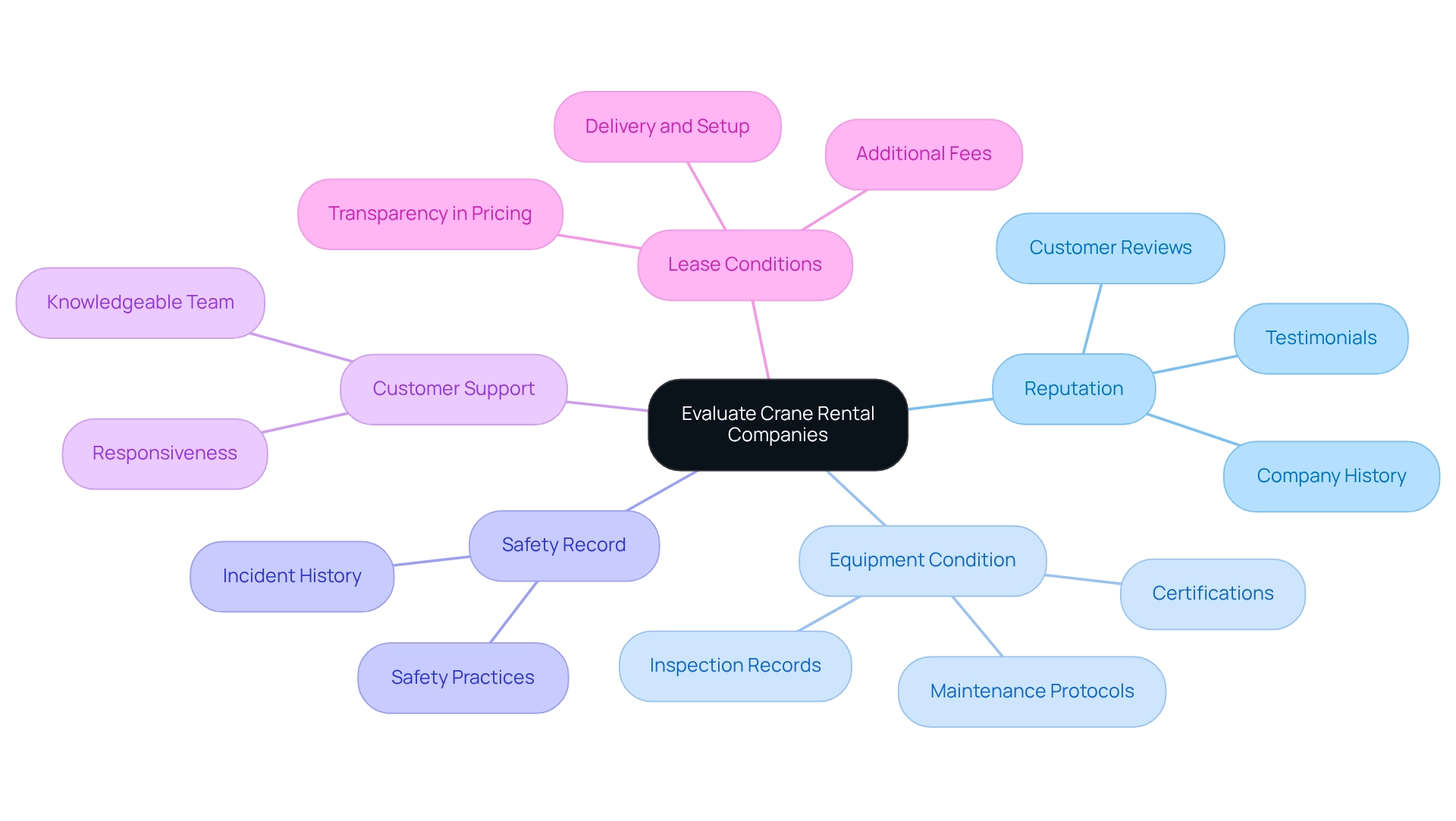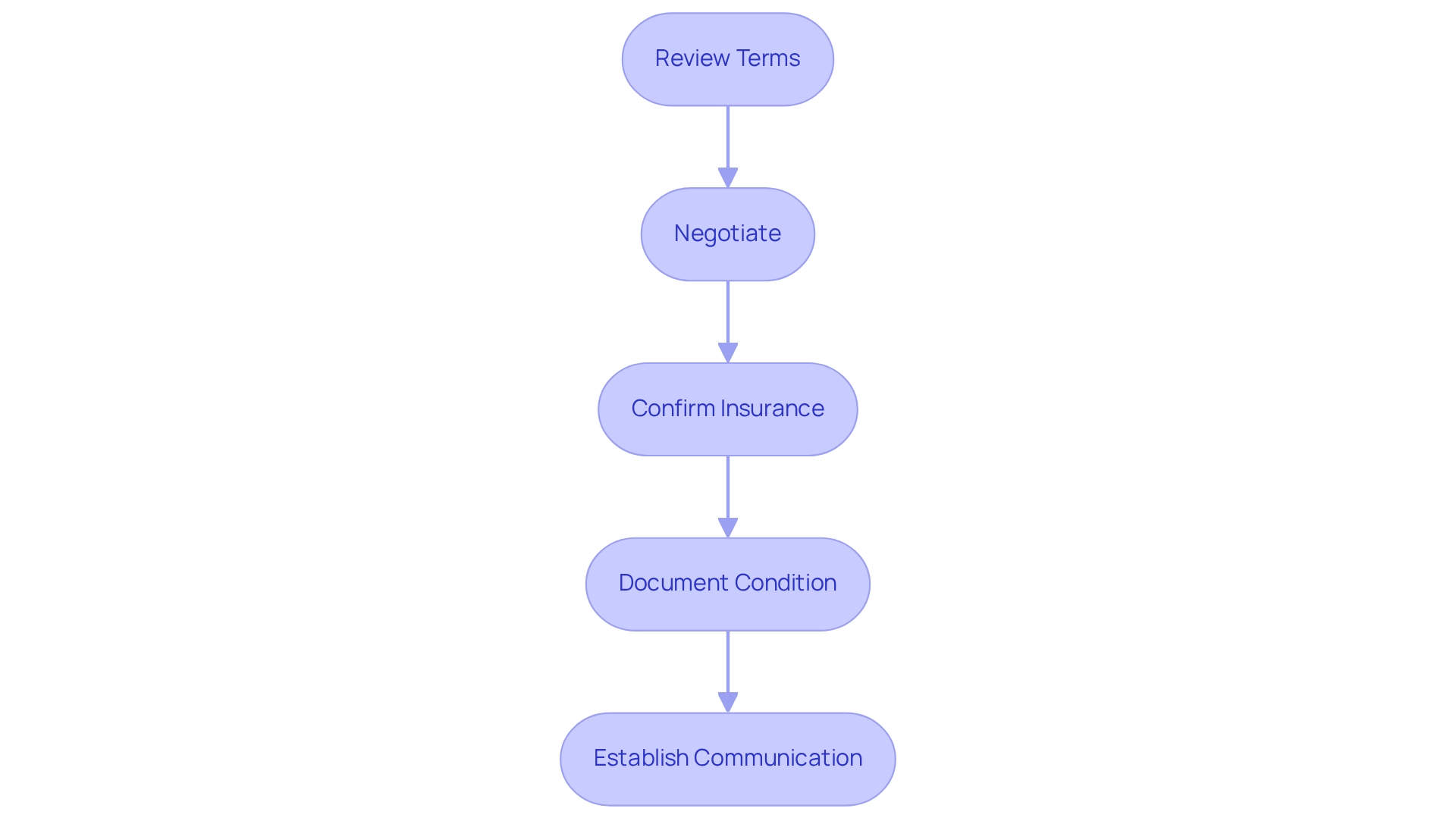Overview
This article provides a comprehensive guide on mastering crane equipment rental for construction projects. It emphasizes the significance of understanding different types of cranes, evaluating project requirements, and selecting dependable rental companies. By detailing various crane types and their specific applications, the article highlights the critical aspects of assessing load weight, site conditions, and safety regulations. Additionally, it offers guidelines for evaluating rental companies based on their reputation and equipment quality.
Understanding the available services is essential for effective project management. Each type of crane serves distinct purposes, and knowing their applications can significantly enhance operational efficiency. For instance, selecting the right crane can ensure that the project runs smoothly while adhering to safety standards. Furthermore, assessing the load weight and site conditions is crucial to prevent accidents and ensure optimal performance.
Reliability and quality are paramount when choosing a rental company. It is advisable to consider companies with a solid reputation and well-maintained equipment. Testimonials from satisfied customers can provide valuable insights into the reliability of the rental service. In addition, examining case studies that demonstrate successful projects can further reinforce the credibility of the rental companies being considered.
To encourage immediate engagement, it is essential to prompt action. By understanding the intricacies of crane equipment rental, construction professionals can make informed decisions that lead to successful project outcomes. Therefore, take the next step in ensuring your project's success by evaluating your equipment rental options today.
Key Highlights:
- Cranes are essential for lifting and transporting heavy materials in construction.
- Tower lifts are ideal for skyscraper construction due to their height and capacity.
- Mobile lifts are versatile and suitable for smaller projects with limited space.
- Crawler lifts provide stability on uneven ground, making them effective for large sites.
- Rough terrain equipment is designed for off-road conditions, enhancing mobility outdoors.
- Gantry structures are used in shipyards for efficient material handling across large areas.
- Jib structures are compact and suited for confined spaces in workshops and factories.
- Key factors for crane rental include load weight, height and reach, site conditions, project timeline, and safety regulations.
- Evaluate crane rental companies based on reputation, equipment condition, safety record, customer support, and lease conditions.
- Finalizing a crane rental agreement involves reviewing terms, negotiating, confirming insurance, documenting equipment condition, and establishing communication.
Introduction
In the dynamic world of construction, the choice of equipment is pivotal to the success of any project. Cranes, in particular, are the backbone for lifting and transporting heavy materials; however, the diverse types and specific applications can often overwhelm project managers.
From towering skyscrapers to challenging terrains, comprehending the various crane types—such as tower, mobile, and crawler cranes—is essential for optimizing both efficiency and safety on job sites.
This article explores the intricacies of crane selection, highlighting the importance of:
- Assessing project requirements
- Evaluating rental companies
- Finalizing agreements to ensure seamless operations
With the right knowledge, construction professionals can adeptly navigate the complexities of crane rental, significantly enhancing their project's success.
Understand Different Types of Cranes and Their Uses
Cranes are indispensable in lifting and transporting heavy materials on construction sites. Understanding the different types of lifting machines and their specific applications is essential for selecting the right tools for your project. Below is an in-depth examination of common crane types:
- Tower Lifts: These structures are vital for erecting tall buildings. Their impressive height and lifting capacity make them ideal for skyscraper constructions, enabling efficient vertical movement of materials.
- Mobile Lifts: Known for their versatility, mobile lifts can seamlessly navigate various terrains, making them suitable for smaller projects or sites with limited space. Their portability enhances their functionality across diverse job locations.
- Crawler Lifts: Equipped with tracks instead of wheels, crawler lifts offer stability and can handle heavy loads on uneven ground. This feature renders them particularly effective for expansive construction sites where ground conditions fluctuate.
- Rough Terrain Equipment: Specifically engineered for off-road conditions, rough terrain equipment excels in outdoor projects where mobility and stability are critical. Their robust construction allows for effective operation in challenging environments.
- Gantry Structures: Frequently utilized in shipyards and warehouses, gantry structures are excellent for transporting heavy loads across large areas. Their design facilitates in spacious environments.
- Jib Structures: Perfect for confined spaces, jib structures are employed for lifting and moving materials within workshops and factories. Their compact design allows for effective operation in restricted areas.
In conjunction with forklifts, hoists significantly enhance building efficiency and safety. They are essential for elevating and moving materials in tight spaces and can work alongside hoists to optimize workflows. By understanding the various types of hoists and forklifts and their applications, you can make informed decisions that elevate the effectiveness and safety of your construction projects.
Looking ahead to 2025, the market share of different types of lifting equipment continues to evolve, with tower models leading in high-rise construction due to their unmatched lifting capabilities. Mobile and rough terrain hoisting machines are also gaining prominence, reflecting the industry's shift toward more adaptable equipment. Insights from the industry indicate that competition in the crane equipment rental sector is intense and growing, which managers must consider when selecting lifting service options.
As Jaya Nagdeo, a Research Manager at Deloitte, emphasizes, "Choosing the appropriate equipment is vital for the effectiveness and safety of building endeavors.

Assess Your Project Requirements and Constraints
When leasing a hoisting device for your building task, a comprehensive evaluation of specific needs and limitations is essential to guarantee optimal performance and safety.
- Load Weight: Accurately ascertain the maximum weight of the materials to be lifted; this will dictate the required lifting capacity of the machine. In 2025, average load weights for construction projects can vary significantly, making this assessment vital. Notably, the equipment rental market accounts for 31% of the United States' market share when combined with Port of Long Beach, underscoring the importance of selecting the appropriate tools for your requirements.
- Height and Reach: Evaluate the required height and reach for placing materials. This evaluation will assist you in choosing the suitable type of lifting equipment, including , whether it be a gantry or a more specialized model.
- Site Conditions: Analyze the job site's terrain and available space. Consider ground stability, access points, and any potential overhead obstructions that could affect hoisting operations.
- Project Timeline: Understand your project schedule and the time frame for which the equipment will be needed. This knowledge is crucial for negotiating rental terms and costs effectively.
- Safety Regulations: Familiarize yourself with local safety guidelines governing lifting operations. Adhering to these regulations is essential to ensure the safety of all individuals involved in the endeavor.
By carefully assessing these factors, you can choose crane equipment rental that meets your project's requirements, ensuring efficiency and safety throughout the construction process. Furthermore, the analytical and detail-focused abilities highlighted in project management are essential for efficiently overseeing equipment leasing projects, ensuring that all elements are thoroughly assessed.

Evaluate Crane Rental Companies for Quality and Reliability
When evaluating crane rental companies, it is essential to consider several key criteria that ensure you make an informed decision.
- Reputation is paramount. Conduct thorough research into the company's history and examine customer reviews. Look for testimonials that underscore their reliability and service quality, as these insights can significantly influence your choice.
- Next, assess the Equipment Condition. Ensure that the cranes are not only well-maintained but also regularly inspected. Inquire about their maintenance protocols and any relevant certifications, as this reflects the company's commitment to safety and performance.
- The Safety Record of the company is another critical factor. It is vital to inquire about their safety practices and incident history. A strong safety record is crucial for minimizing risks on-site and ensuring a secure working environment.
- Additionally, evaluate the Customer Support offered. A responsive and knowledgeable team can effectively assist with any issues that arise during the leasing period, enhancing your overall experience.
- Finally, scrutinize the Lease Conditions. Thoroughly examine the lease agreements, paying close attention to transparency in pricing, including any additional fees for delivery, setup, or maintenance.
By thoroughly assessing these factors, you can select that aligns with your project's quality and reliability criteria, ensuring a successful and efficient operation.

Finalize Your Crane Rental Agreement and Terms
After selecting a hoisting equipment leasing firm, it is crucial to finalize your lease contract effectively. Begin with these essential steps:
- Review Terms: Thoroughly examine the leasing agreement, focusing on the duration, costs, and any additional fees that may apply.
- Negotiate: Feel empowered to negotiate any terms that appear unclear or unfavorable. Address concerns regarding pricing, delivery, or maintenance services directly with the provider.
- Confirm Insurance: Ensure that the leasing company provides adequate insurance coverage for the equipment, as well as protection against potential liabilities throughout the leasing term.
- Document Condition: Prior to taking possession of the crane, document its condition using photos or a checklist. This practice will help prevent disputes related to damage upon return.
- Establish Communication: Designate a point of contact with the leasing company for any questions or issues that may arise during the leasing period.
By adhering to these steps, you can facilitate a seamless rental process while safeguarding your interests throughout the project.

Conclusion
Selecting the right crane for a construction project is a multifaceted process that significantly influences both efficiency and safety on the job site. Understanding the diverse types of cranes available—such as tower, mobile, crawler, and gantry cranes—enables project managers to choose the most suitable equipment based on specific project requirements. Each crane type serves unique purposes, making it essential to align equipment choice with project needs.
In addition to understanding crane types, careful assessment of project constraints, such as load weight, site conditions, and safety regulations, is crucial. These evaluations ensure that the selected crane will perform optimally within the project's context, minimizing risks and enhancing operational efficiency. Furthermore, selecting a reputable crane rental company is key to securing quality equipment and reliable service, which can ultimately impact the success of the project.
Finalizing the rental agreement with attention to detail—reviewing terms, negotiating where necessary, and ensuring adequate insurance coverage—further safeguards the interests of all parties involved. By following these steps, construction professionals can navigate the complexities of crane rental with confidence, paving the way for safer and more effective project execution.
In conclusion, the right crane, combined with thorough planning and reliable partnerships, lays the groundwork for successful construction endeavors. By prioritizing informed decision-making and meticulous evaluations, project managers can not only enhance productivity but also foster a safer work environment, ensuring that every lift contributes to the overall success of the project.
Frequently Asked Questions
What are cranes used for in construction?
Cranes are indispensable for lifting and transporting heavy materials on construction sites.
What are the different types of cranes mentioned in the article?
The article discusses several types of cranes, including Tower Lifts, Mobile Lifts, Crawler Lifts, Rough Terrain Equipment, Gantry Structures, and Jib Structures.
What are Tower Lifts used for?
Tower Lifts are vital for erecting tall buildings, particularly skyscrapers, due to their impressive height and lifting capacity that enables efficient vertical movement of materials.
What is the advantage of Mobile Lifts?
Mobile Lifts are versatile and can navigate various terrains, making them suitable for smaller projects or sites with limited space.
How do Crawler Lifts differ from other lifts?
Crawler Lifts are equipped with tracks instead of wheels, offering stability and the ability to handle heavy loads on uneven ground, making them effective for expansive construction sites.
What conditions are Rough Terrain Equipment designed for?
Rough Terrain Equipment is specifically engineered for off-road conditions, excelling in outdoor projects where mobility and stability are critical.
Where are Gantry Structures commonly used?
Gantry Structures are frequently utilized in shipyards and warehouses for transporting heavy loads across large areas.
What is the purpose of Jib Structures?
Jib Structures are designed for lifting and moving materials within confined spaces, such as workshops and factories, due to their compact design.
How do hoists and forklifts contribute to construction efficiency?
Hoists and forklifts enhance building efficiency and safety by elevating and moving materials in tight spaces, optimizing workflows when used together.
What trends are expected in the lifting equipment market by 2025?
By 2025, tower models are expected to lead in high-rise construction due to their unmatched lifting capabilities, while mobile and rough terrain hoisting machines are gaining prominence for their adaptability.
What does Jaya Nagdeo emphasize about choosing equipment?
Jaya Nagdeo emphasizes that choosing the appropriate equipment is vital for the effectiveness and safety of building endeavors.




